General information
Photo tour guided by Patrick Dieudonne, french professional photographer. Bookings, etc. by ExpePhoto, our own travel agency. Small groups of up to six photographers.
PRICE: 2850 € (excluding flight)
Single room supplement: about 300 EUR
Bookings : Please visit this Shetland page on Expephoto.com
Program : (program can be slightly adapted to the group wishes or the weather conditions)
Day 1: Saturday
Departure from Paris or other airport of your choice to Aberdeen, NE of Scotland. Arrival around 13.30 in Aberdeen, then flight to Sumburgh airport. Arrival around 16.00. We collect our rental car at the airport and can begin to explore the south of the island, especially the southern tip of Shetland, Sumburgh Head, a place of spectacular cliffs, where puffins are easy to photograph. They can be photographed in flight at close range in the evening when they return to their burrows. Many other seabirds are also present on these cliffs. Killer whales, dolphins and even whales (humpback) are sometimes seen from Sumburgh Head.
Overnight: B & B in the southern part of the island (preferably) or in Lerwick, depending on availability.
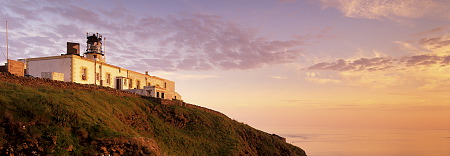
Sumburgh Head, the lighthouse at sunset
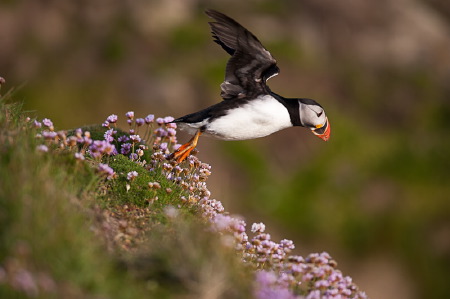
Puffin at Sumburgh Head
Day 2: Sunday
Morning: The south part of Mainland is quite different from the rest of the archipelago. Here the land is fertile and green (underlying rocks are limestone or sands), while further north moorland takes over. Many places are very photogenic, for example the famous St Ninian tombolo, a long sand spit connecting St Ninian to Mainland (the finest example in Europe) and Lake Spiggie, surrounded by hills where sheep graze and open to the sea at a short distance. The low-lying islands of Trondra and Burra, on Mainland's west coast, also offer beautiful views and small villages pleasantly sited. In good weather, between the blue sea and sandy beaches, on which you can see seals basking, the whole area is really enchanting. We will visit also a ancient crofthouse, typical dwelling of the old times in Shetland (Crofthouse Museum), a fine example of traditional architecture (Dunrossness).
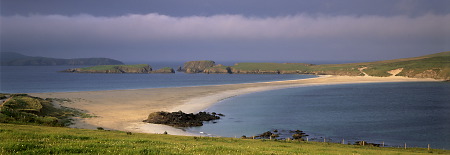
Saint Ninian tombolo
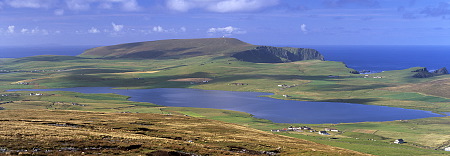
Spiggie Loch
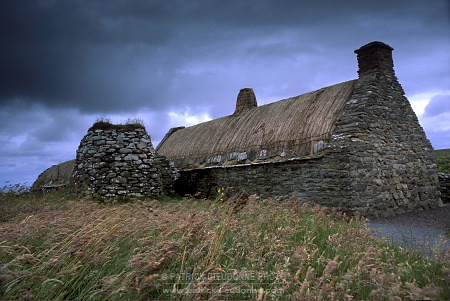
Crofthouse Museum, Dunrossness
Afternoon: In the afternoon, we will take a boat trip to the island of Mousa, where stands the famous Mousa broch, 2000 years old, the best preserved throughout Scotland. A broch is a fortified tower, typically Scottish, built in the Iron Age, for defensive purposes. The broch has a massive bottom and is narrower at the top. It is more than 13 m high, and one can visit the interior. But this is not the only attraction of Mousa, the whole island is a haven for wildlife, and it is usually easy to take good pictures of black guillemots, fulmars, arctic or great skues. Harbour seals are abundant on the east coast. During the crossing, it is often possible to see porpoises, well present in this area.
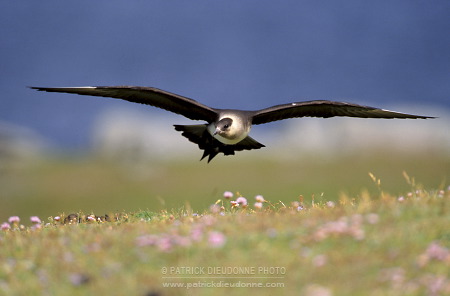
Arctic Skua patrolling Mousa
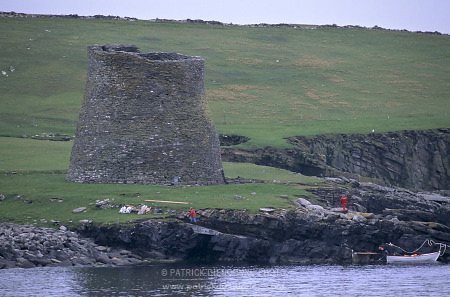
Moiusa broch, 2000 years old

Harbour seal, Mousa
Night in Lerwick, hotel or B & B, we'll explore the old city and its baronial architecture.
Day 3: Monday
We take the ferry from Lerwick to Bressay and a small dinghy to the island of Noss, a national reserve. After a few km walk along the low coast, we arrive at the Noup of Noss (181 m), an extraordinary place where each niche in the rock, each ledge is occupied by colonies of guillemots, or Gannets (8000 pairs), an incredible sight. The smell and sound are amazing, while at your feet, in the grass, puffins come and go from their burrows to the sea below. There are also varied and spectacular vistas all along the coast. We spend most of the day on the island , which is not too much to appreciate it fully. In the evening if time permits we will visit the island of Bressay, its lighthouse, built by the Stevenson family, and probably enjoy beautiful views of the old town of Lerwick from Bressay, across the Strait .
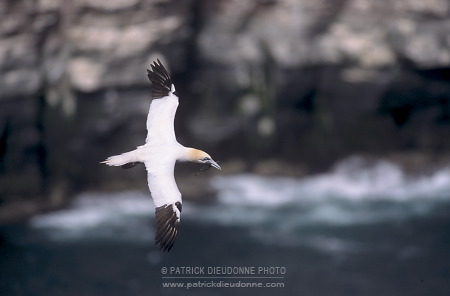
Gannet, Noss, Shetland
Night at Lerwick, hotel or B&B.
Day 4 : Tuesday
In the morning, around 7am, we embark again to Noss from Lerwick, on board a fishing boat. I will try to get an early departure for our group, because the majority of boat tours for Noss start too late to my taste. It is possible to approach the birds very close by boat, while they are fishing at the bottom of the cliffs. We will be able to enjoy this great natural spectacle from a different perspective. A visit that beautifully complements our exploration of the previous day, and produces radically different pictures, perhaps even more spectacular. Near Lerwick the boat allows us a very close encounter with grey seals used to human presence, another chance for new and interesting pictures.
In the afternoon we will explore other parts of Shetland to the north and west, particularly the West Mainland peninsula, seascapes, landscapes dotted with small lakes where the red-throated loon nests, and very interesting neolithic archaeological remains (oval houses, Stanydale temple). In the evening we’ll head to another peninsula further north, Northmavine, that will be explored further the next day. Night at Hillswick, Northmavine, in B & B or hotel.
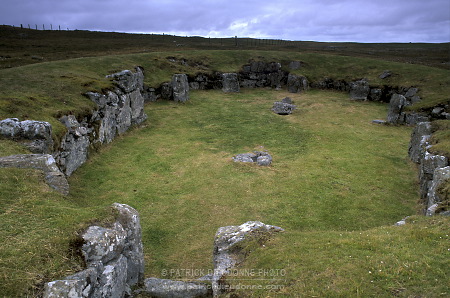
Stanydale temple, Shetland
Day 5 : Wednesday
We spend the day on Northmavine, a remarkable place in many aspects. Northmavine boasts the highest hill in Shetland, Ronas Hill, a large granite dome about 10 km in diameter, which, despite its rather modest height (450 m), hosts many arctic and subarctic plants and species, and presents a climate comparable to Ben Nevis, the highest mountain in Scotland. Ronas Hill dominates Ronas Voe, the longest « voe » or fjord in the Shetland islands, views over the fjord are pleasant and varied.
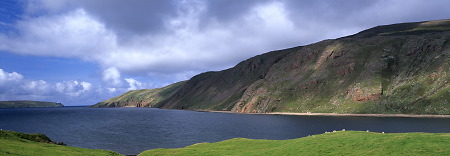
Ronas Voe, Northmavine
But Northmavine also offers an especially remarkable coastal scenery, unique in Europe. A Eshaness the sea has eroded an ancient volcano, producing stunning erosion structures such as vents and chasms inland. The basaltic coast is literally torn out by violent winter storms, with many stacks, reefs and rocks in the sea. A beautiful place, especially at sunset. A short distance away, in St Magnus Bay and near Hillswick, one can find also very nice red sandstone cliffs and stacks with remarkable shapes, such as the Drongs, shaped like a Gothic castle, or Dore Holm, the "drinking horse", a massive arch under which a ship can pass. These special places house also, of course, their share of seabirds, including kittiwakes and guillemots.
Night at Hillswick, Northmavine, hotel or B & B.
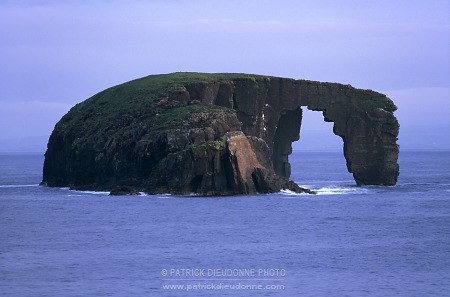
Dore Holm, the "drinking horse", St Magnus Bay
Day 6: Thursday
We continue our journey to the northern islands, and take the ferry to Yell and Fetlar, the green "garden of Shetland", which hosts interesting plants and animals, difficult to find elsewhere in Shetland. The island is pleasant, with a feel like being out of time as will show a visit to Brough Lodge, an old abandoned mansion. Nearby otters are often seen, and I have taken photos of them too in this place (and in other places on the island). Otter is probably the most iconic Shetland species, with higher densities all over Shetland than anywhere else in Europe (one otter per km of shore). Observation is almost guaranteed, because we will be in some of the best places, however good otter photography is not easy, because otters are rather shy, with good sight and ears, a developed sense of smell. We will spend some time on otters, but results can never be granted.
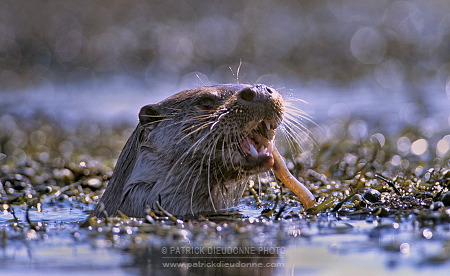
Otter with prey, Shetland
A few otters are more tolerant of human presence when they live near the ferry docks, it’s a matter of chance, but in all cases, Fetlar is one of the very best places for this species. We also have a good chance to photograph the very rare (in Britain) and funny red-necked Phalarope (Fetlar boasts 90% of the total population in Britain). Imagine a bird with no fear of humans, a quite hyperactive bird, chasing mosquitoes right at your feet. A very special species where the female has more colors than the males, which incubate and take care of the young birds.
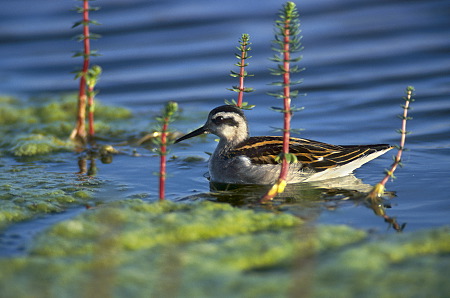
Phalarope
In the evening we take the ferry to Unst, the northernmost island of the archipelago. We take our quarters in a former RAF military base (Saxa Vord radar station), recently converted into a touristic resort complex. Saxa Vord resort is conveniently located just north of the island, close to the great national reserve of Hermaness.
Night at Saxa Vord resort, Unst.
Day 7 : Friday
We need the day to explore Unst and Hermaness National Nature Reserve at our own pace. There are a few km walks today, as the spectacular cliffs of the west coast are only accessible by foot. However, the main tracks are well laid out and allow relatively easy access to Hermaness, there is no more difficult passages through peat bogs or wetlands as it was the case in the past. Hermaness has a very special atmosphere : the sky is criss-crossed by great skuas, very numerous here, or gannets, and the big cliffs offer great views in all directions, and especially to the north. Muckle Flugga and its lighthouse is specially photogenic. Gannets and skuas in flight or on the cliffs offer many opportunities, and it is also possible to sit in some places very close to puffins, and try a mix of landscape and wildlife photography in stunning scenery. We will be on the cliffs at the end of the day to get the best light.
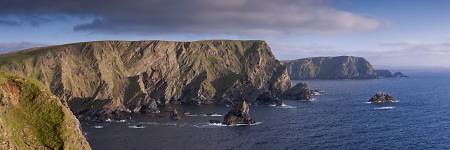
Hermaness NNR, Unst
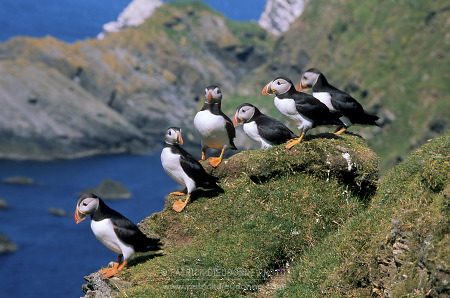
Puffins, Hermaness, Unst, Shetland
Night at Saxa Vord resort, Unst.
Day 8 : Saturday
We spend another morning on Unst for more landscapes and Shetland ponies also (as it is on Unst that Shetland ponies are most numerous) . We can also visit Keen of Hamar botanical reserve, to discover a few subarctic plants, and especially the only endemic flower in Shetland, Edmonston’s Chickweed (Shetland mouse-ear – Cerastium nigrescens). We then take the ferry to the south, through Yell, that we will explore a bit further. This island, which seems less attractive than its counterparts at first, can offer beautiful pictures in some places if the light is present, we will be ready to exploit it. It will be possible to explore in the afternoon new places on Mainland North (Lunna Ness, for example, which hosts a good otter population) or more to the south, according to circumstances. In the evening, we can for example visit Scalloway, the ancient capital of Shetland (beautiful medieval castle ), or any other place where you want to return in this area. Night at Lerwick, hotel or B & B.
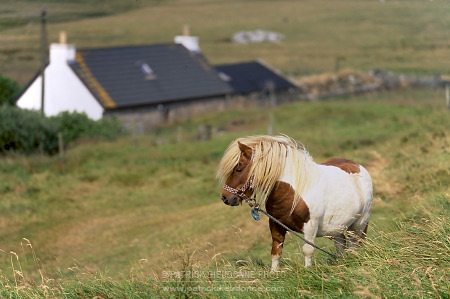
Shetland pony
Day 9 : Sunday
Free time at Lerwick for some shopping or photography, depending on your taste. Road to Sumburgh airport, flight to Aberdeen, at 1:30 p.m. Flight Aberdeen-Paris arrives at 10 PM .
Share this page on Facebook
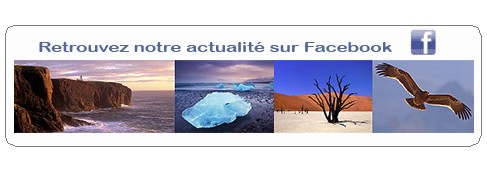
>> Return to previous page
|
|
What's included:
• All ground transports.
• Full board
• Hotel and B&B (double room basis)
• Pro advices and tips in the field.
What is not included:
• Travel insurances
• Photo gear
• Alcoholic drinks and personal items.
Photo Equipment
• SLR (digital or film)
• Sturdy tripod, ballhead, etc.
• Lenses for landscape photography: wide-angle (below 24 mm), transstandard 24 or 28-70 mm, medium telephoto zoom lens (70-200). A longer focal length, but not too heavy, can sometimes be useful for details or wildlife (300-400 mm).
Fitness
It is necessary for this trip in fairly remote areas of Scotland to be in good shape and properly equipped (see below). Nevertheless this tour is not about hiking or trekking. Car allows close or relatively close access to the main points of view, but moderately difficult walks are sometimes necessary to find the best spots.
Weather / clothing
• Clothing: Whatever the season, Scotland can be cool, especially morning and evening. In summer, it can be quite warm during the day. In all cases, humidity is a factor to consider. The months of May and June, however, are the driest months of the year in Scotland.
We recommend multi-layered clothing, with the last layer being windproof breathable Goretex. Woolen hat is recommended in your luggage, it will bring you extra comfort in windy conditions, fine gloves can be useful in mid-season.
• Shoes: this is not to be neglected. The land in Scotland is often wet and boggy, and you will need good walking and waterproof shoes. The best shoes, for me, are all leather shoes with a goretex membrane. They must be worn before first use in Scotland, to prevent blisters. Gaiters are recommended for complete protection against moisture. Rubber boots can be useful in some rare cases, but don't bring them in your luggage, they could be bought locally if necessary.
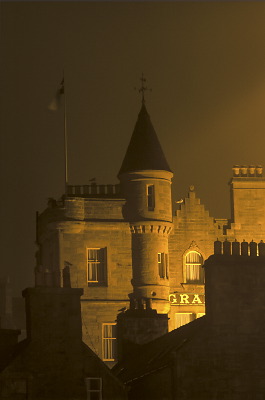
Old town, Lerwick

Town Hall, Lerwick
Accommodation and food:
Accommodation is provided in Guesthouse / B & B **** or *** or hotel ** or *** , in double rooms. Single rooms on request.
Food: Breakfast and dinner at the hotel or B & B. Breakfast can be "continental" (classic) or Scottish (beans, sausages, etc.). Lunch can be taken in a pub or restaurant, or be a simple picnic, according to the conditions and places. Wherever possible, we prefer a real meal.
Transportation:
We'll use a 9 seater van for a group of 6 photographers max. so you'll have enough space for equipment and luggage.
Bookings
Please visit this Shetland page on Expephoto.com
Airfare:
From Paris to the Shetland islands (Paris - Aberdeen - Sumburgh) approx. 450-500 euros. Contact us in all cases for hours, advice and tips, we'll be happy to help.
Other questions?
Contact us using the form above or call if you need further information.
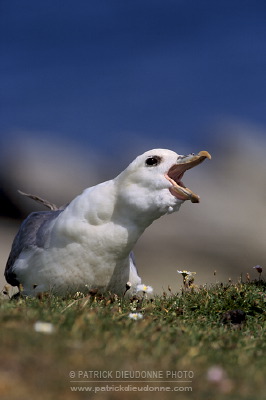
Fulmar
Contact
Patrick Dieudonné Photo
9 rue de Sampigny
55300 Han sur Meuse
FRANCE
Tel: + 33 (0)3 29 92 08 89
Mobile: +33 (0)6 79 63 27 25
We speak english end French.
Share on Twitter
Follow us on Twitter
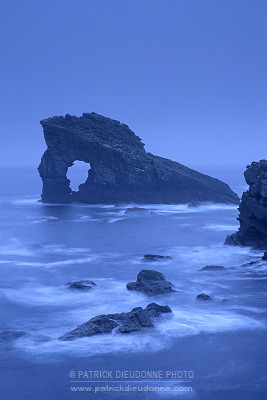
Gaada Stack natural arch, Foula
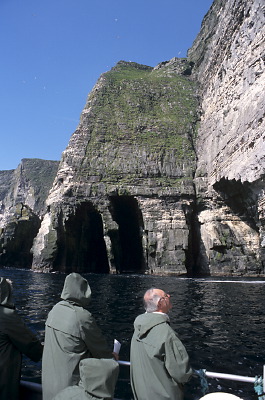
Noss by boat
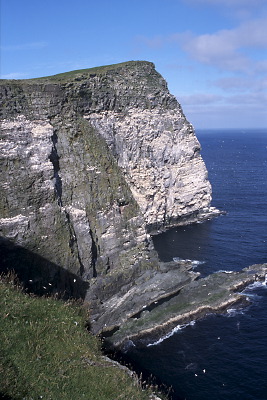
The Noup of Noss
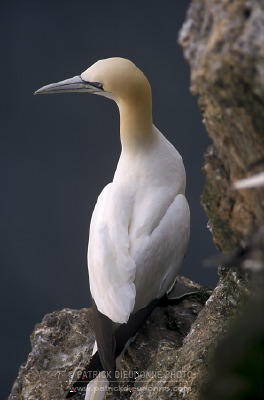
Gannet, Hermaness
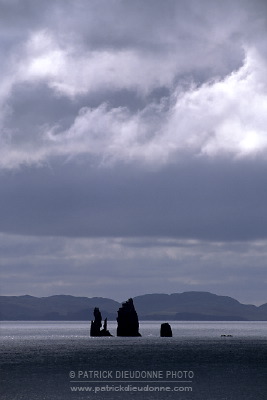
The Drongs, Northmavine
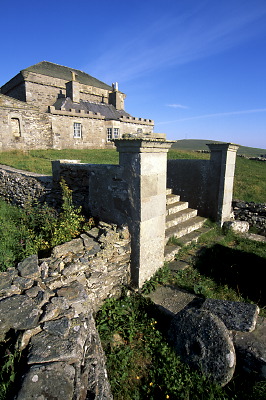
Brough Lodge, Fetlar
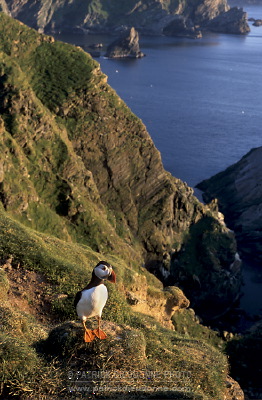
Puffin, Hermaness cliffs
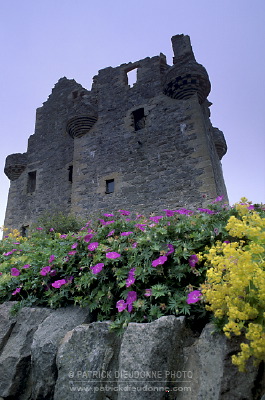
Scalloway Castle
|